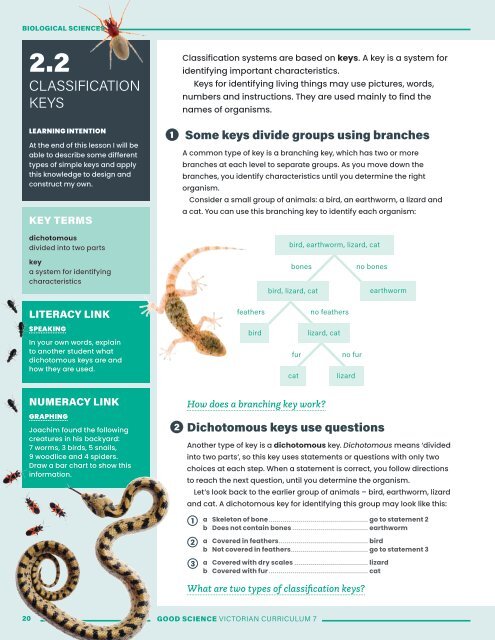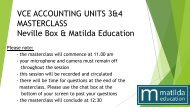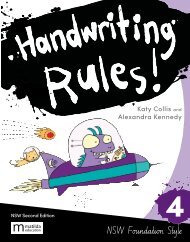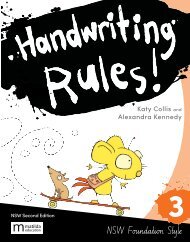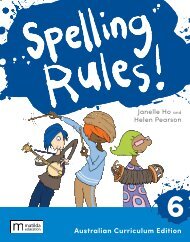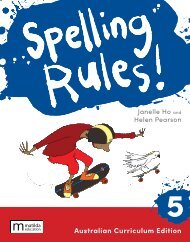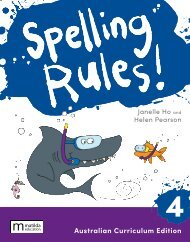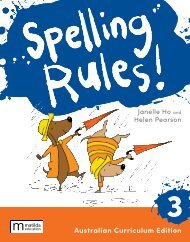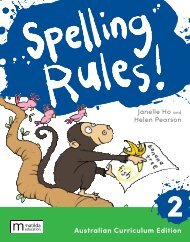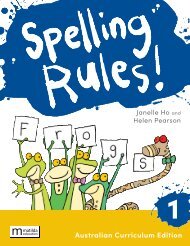Good Science Victorian Curriculum Year 7
Digital sample of Matilda's newest publication, Good Science Victorian Curriculum Year, authored by Emma Craven and Aaron Elias. For more information visit www.matildaeducation.com.au or email Katrina Tucker, katrinatucker@matildaed.com.au
Digital sample of Matilda's newest publication, Good Science Victorian Curriculum Year, authored by Emma Craven and Aaron Elias. For more information visit www.matildaeducation.com.au or email Katrina Tucker, katrinatucker@matildaed.com.au
Create successful ePaper yourself
Turn your PDF publications into a flip-book with our unique Google optimized e-Paper software.
BIOLOGICAL SCIENCES<br />
2.2<br />
CLASSIFICATION<br />
KEYS<br />
LEARNING INTENTION<br />
At the end of this lesson I will be<br />
able to describe some different<br />
types of simple keys and apply<br />
this knowledge to design and<br />
construct my own.<br />
KEY TERMS<br />
dichotomous<br />
divided into two parts<br />
1<br />
Classification systems are based on keys. A key is a system for<br />
identifying important characteristics.<br />
Keys for identifying living things may use pictures, words,<br />
numbers and instructions. They are used mainly to find the<br />
names of organisms.<br />
Some keys divide groups using branches<br />
A common type of key is a branching key, which has two or more<br />
branches at each level to separate groups. As you move down the<br />
branches, you identify characteristics until you determine the right<br />
organism.<br />
Consider a small group of animals: a bird, an earthworm, a lizard and<br />
a cat. You can use this branching key to identify each organism:<br />
bird, earthworm, lizard, cat<br />
key<br />
a system for identifying<br />
characteristics<br />
bones<br />
bird, lizard, cat<br />
no bones<br />
earthworm<br />
LITERACY LINK<br />
feathers<br />
no feathers<br />
SPEAKING<br />
In your own words, explain<br />
to another student what<br />
dichotomous keys are and<br />
how they are used.<br />
bird<br />
fur<br />
cat<br />
lizard, cat<br />
no fur<br />
lizard<br />
NUMERACY LINK<br />
GRAPHING<br />
Joachim found the following<br />
creatures in his backyard:<br />
7 worms, 3 birds, 5 snails,<br />
9 woodlice and 4 spiders.<br />
Draw a bar chart to show this<br />
information.<br />
2<br />
How does a branching key work?<br />
Dichotomous keys use questions<br />
Another type of key is a dichotomous key. Dichotomous means ‘divided<br />
into two parts’, so this key uses statements or questions with only two<br />
choices at each step. When a statement is correct, you follow directions<br />
to reach the next question, until you determine the organism.<br />
Let’s look back to the earlier group of animals – bird, earthworm, lizard<br />
and cat. A dichotomous key for identifying this group may look like this:<br />
1<br />
2<br />
3<br />
a Skeleton of bone .................................................. go to statement 2<br />
b Does not contain bones ...................................... earthworm<br />
a Covered in feathers ............................................. bird<br />
b Not covered in feathers ....................................... go to statement 3<br />
a Covered with dry scales ..................................... lizard<br />
b Covered with fur .................................................. cat<br />
What are two types of classification keys?<br />
20 GOOD SCIENCE VICTORIAN CURRICULUM 7


